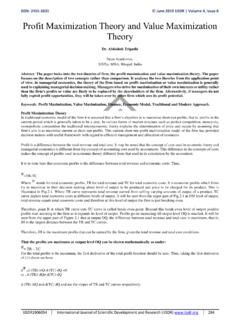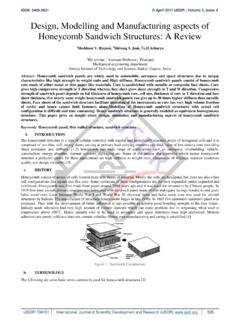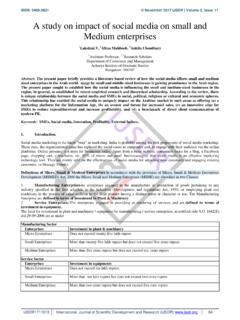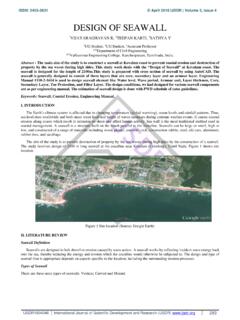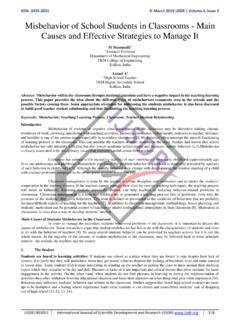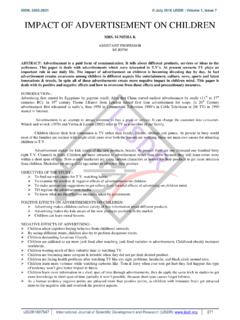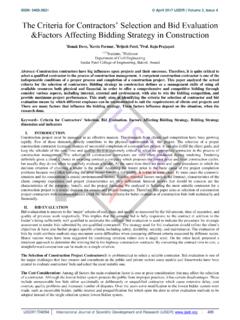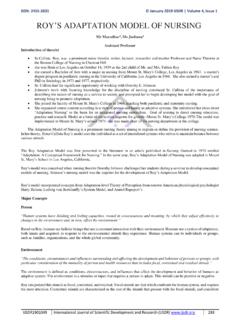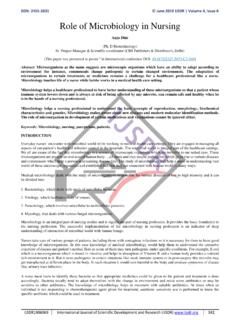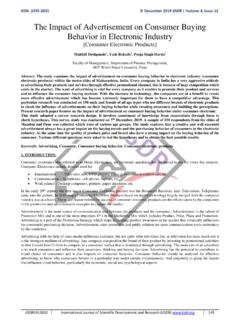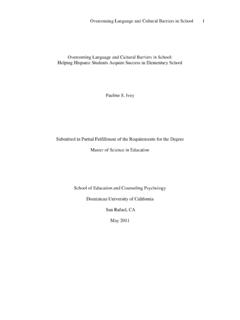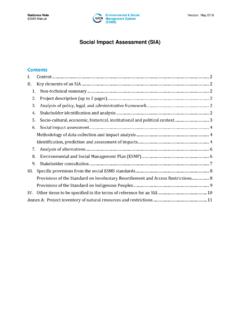Transcription of Impact of Globalization on Human Resource Management
1 ISSN: 2455-2631 February 2019 IJSDR | Volume 4, Issue 2 IJSDR1902015 International Journal of Scientific Development and Research (IJSDR) 82 Impact of Globalization on Human Resource Management 1Dr. Jai Kumar Sharma Associate Professor Akal College of Commerce & Management Eternal University, Baru Sahib Sirmour (HP) INDIA Abstract: Globalization is characterized by the free flow of technology and Human resources across national boundaries presenting an ever-changing competitive business environment. In the global competition within the flat and connected new world, decision making in organizations has become increasingly intricate and convoluted. The new global world has widened the talent pool for excellent and marginal workers, and for permanent and fluid workers. The pace of Globalization is increasing continuously in terms of markets for goods and services, investment and business opportunities within one or more organizations.
2 This transformation caused by Globalization affects all the department in an organization in which Human Resource Management is not left out in this transformation crusade as it has obligation to move along with the changing demands of the Globalization process. The roles and responsibilities of Human Resources departments are transforming as the modern business faces pressures of Globalization . The global supply of talent is short of its long-term demand, and the gap is a challenge for employers everywhere. Now organizations need to place greater emphasis on attracting Human capital rather than financial capital. Global staffing and Management of a workforce diverse in culture and language skills, and dispersed in different nations are the key goals of global Human resources. This paper examines the Impact of the workforce on Human Resource Management either locally or internationally also it revealed the various factors driving Globalization in the workforce and the issues and challenges that confront the Human Resource Management in the global markets, and also the benefits of Globalization Human Resource Information System (HRIS) to the Human Resource (HR) department.
3 Keywords: Globalization , Investment, Human Resource Management , Business, and Human Resources Information System. INTRODUCTION The concept of Globalization refers to an increasing flow of goods and resources across national borders and the emergence of a complementary set of organizational structures to manage the expanding network of international economic activity and transactions. Globalization is expected to accelerate growth in developing countries. Globalization involves technological, economic, political and cultural exchanges made possible largely by advances in communication, transportation, and infrastructure. Armstrong (2004) defined Human Resource Management (HRM) as the function within an organization that focuses on recruitment of Management of, and providing direction for the people who work in the organization. Also, Human Resources Management is the organizational function that deals with issues related to people such as compensation, hiring, performance Management , organization development, safety, wellness, benefits, employee motivation, communication, administration and training.
4 Human Resource Management is also a strategic and comprehensive approach to managing people and the workplace culture and environment. Effective HRM enables employees to contribute effectively and productively to the overall company direction and the accomplishment of the Management is moving away from traditional personnel, administration, and transactional roles, which are increasingly outsourced. Human Resource Management is moving away from traditional personnel, administration, and transactional roles, which are increasingly outsourced. HRM is now expected to add value to the strategic utilization of employees and that employee programs Impact the business in measurable ways through Globalization , therefore Human Resources department are transforming as the modern business faces numerous and complex challenges, and exploit opportunities. The transformation of Human resources today is a direct call of the rapid changes within business due to factors such as Globalization .
5 In the global competition within the flat and connected new world, decision making in organizations has become increasingly intricate and convoluted. The system will help to analyze the data to provide business insights, predict future needs and develop strategies to fill those needs. The global supply of talent is short of its long-term demand and the gap is a challenge for employers everywhere. The shortage between the demand and supply of talent is likely to continue to increase, notably for highly skilled workers and for the next generation of multi-national organization. Now, more than ever, organizations need to place greater emphasis on attracting Human capital rather than financial capital. Because capital is broadly available from investors and lenders, and innovations can be duplicated relatively easily and quickly, effective Human Resource Management is the best way to differentiate one company from another.
6 Trending Concepts in HRM due to Globalization Specialized Application Use of Information technology Reducing Manual Efforts Diversity in Work Force Work Life Balance ISSN: 2455-2631 February 2019 IJSDR | Volume 4, Issue 2 IJSDR1902015 International Journal of Scientific Development and Research (IJSDR) 83 Global staffing and global leadership development are the two components of global Human resources with the greatest potential for powerful leverage for global firms. Only the multinationals that will be willing to adapt their Human Resource practices to the changing global labour market conditions will be able to attract, develop and retain the right talent, and will likely succeed in the global competition .Most emerging nations with large populations, including Brazil, Russia, India, and China, may not be able to sustain a net surplus workforce with the right skills for much longer.
7 Now, more than ever, organizations need to place greater emphasis on attracting Human capital rather than financial capital. Because capital is broadly available from investors and lenders, and innovations can be duplicated relatively easily and quickly, effective Human Resource Management is the best way to differentiate one company from another. DRIVING FACTORS OF Globalization Over the years, the relative success of globalisation is evident in terms of increased foreign trade and capital flows, acceleration of growth rates and rising real per capital GDP in the those countries that have opened up their economies more to the rest of the world than those that have preferred to follow a close economy model. It is a known fact that countries such as China, Korea, Mexico, Malaysia and Thailand have experienced faster growth in per capital real increase owing to their expanding external sector and liberalised approach towards globalisation than slowly global sing developing countries such as Ghana, India, Pakistan, and Sri Lanka among several others.
8 Globalisation essentially implies much closer integration of the world economy that has assured many hopes as well as fears. The policy makers of a developing economy have to take an account of both credit and debit side of the phenomenon. The last two decades have seen the evolution of the global manufacturing environment, majority of the manufacturers have global presence through exports, strategic alliances, joint ventures or as a part of a committed strategy to sell and produce in foreign markets. Conceptual Framework Over the years, the relative success of globalisation is evident in terms of increased foreign trade and capital flows, acceleration of growth rates and rising real per capital GDP in the those countries that have opened up their economies more to the rest of the world than those that have preferred to follow a close economy model. It is a known fact that countries such as China, Korea, Mexico, Malaysia and Thailand have experienced faster growth in per capital real increase owing to their expanding external sector and liberalised approach towards globalisation than slowly global sing developing countries such as Ghana, India, Pakistan, and Sri Lanka among several others.
9 Globalisation is not a novel phenomenon. Yet, in the contemporary era, its approach tends to be fresh, new, mote friendly and warming. Globalisation essentially implies much closer integration of the world economy that has assured many hopes as well as fears. The policy makers of a developing economy have to take an account of both credit and debit side of the phenomenon. Global Market forces Global Cost Forces Technological Forces Political and Macroeconomic Forces Global Cost Forces Technological forces Globalization Process Global Market Forces Political and Micro Economic forces For rcesrces ISSN: 2455-2631 February 2019 IJSDR | Volume 4, Issue 2 IJSDR1902015 International Journal of Scientific Development and Research (IJSDR) 84 Global Market forces There is tremendous growth potential in the global markets which resulted in intensified foreign competition in local markets which forces the small-and-medium-sized companies to upgrade their operations and even consider expanding internationally.
10 There has also been growth in demand which necessitates the development of a global network of manufacturing bases and markets when the markets are global, the production - planning task of the manager becomes difficult on one hand and allows more efficient utilization of resources on the others. Technological Forces A peculiar trend which was prevalent in the last decade, besides Globalization , was a limited number of producers which emerged due to diversity among products and uniformity across national markets. Product diversity has increased as products have grown more complex and differentiated and product life cycles have shortened. These have been diffusion of technological knowledge and global low-cost manufacturing locations have emerged. In response to this diffusion of technological capability, multinational firms need to improve their ability to tap multiple sources of technology located in various countries.
